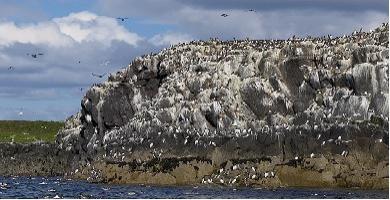 The aim of the MPA Challenge was to gain an understanding of whether the available data are sufficient to predict the ecological coherence of a network of MPAs and how representative they might be of the wider North Sea environment. The work for this Marine Protected Areas (MPA) Challenge was undertaken by MacAlister Elliot & Partners (MEP). The Marine Protected Areas Challenge has addressed the stages of work required for a desk-based assessment to analyse the existing European (and Norwegian) network of marine protected areas, both for national and international sites, and to determine whether the network constitutes a representative and coherent network as described in article 13 in the Marine Strategy Framework Directive. The assessment was made using publically available data or data provided upon request to national and international authorities.
The aim of the MPA Challenge was to gain an understanding of whether the available data are sufficient to predict the ecological coherence of a network of MPAs and how representative they might be of the wider North Sea environment. The work for this Marine Protected Areas (MPA) Challenge was undertaken by MacAlister Elliot & Partners (MEP). The Marine Protected Areas Challenge has addressed the stages of work required for a desk-based assessment to analyse the existing European (and Norwegian) network of marine protected areas, both for national and international sites, and to determine whether the network constitutes a representative and coherent network as described in article 13 in the Marine Strategy Framework Directive. The assessment was made using publically available data or data provided upon request to national and international authorities.
The challenge assessed the availability and quality of data from the perspective of a basic marine user wishing to obtain information on the North Sea MPA network.
The method was based on the approach suggested by OSPAR to assess ecological coherence. Full details are available from OSPAR (2006).
- Features and Representivity: calculate how represented a particular feature (species or habitat) is in the network (i.e. how many times intertidal mudflat habitat appears in the North Sea MPA network).
- Resilience: calculate the overall size of the North Sea MPA network and the proportion of each feature protected within the boundaries of each site.
- Connectivity: using proximity as a proxy for connectivity, calculate how closely connected particular features are to each other in neighbouring MPAs.
- Management: review the marine management for the study area to determine if the MPA network operates as part of a wider management structure.
Relevant marine protected areas within the study area were identified and acquired. The OSPAR set of MPAs was used as a starting point and some components were replaced where a newer source was identified (e.g. UK SACs). Nationally designated MPAs were added and the data checked against countries’ national spatial datasets where they were identified and also compared to the world database on protected areas. An ESRI layer file package was produced. This contains the MPA data and some basic background mapping (land and maritime boundaries).
The final output of the challenge and lessons learnt was outlined in detail in the challenge’s Data Adequacy Report (DAR), which was delivered in May 2015. The outcomes have been presented:
- at the project Expert Panel meeting (after which comments and amendments were made to the report);
- to EMODnet steering committee meetings; and
- at an EMODnet checkpoint meeting.
Click here to view the Marine Protected Areas Challenge Data Adequacy Report
